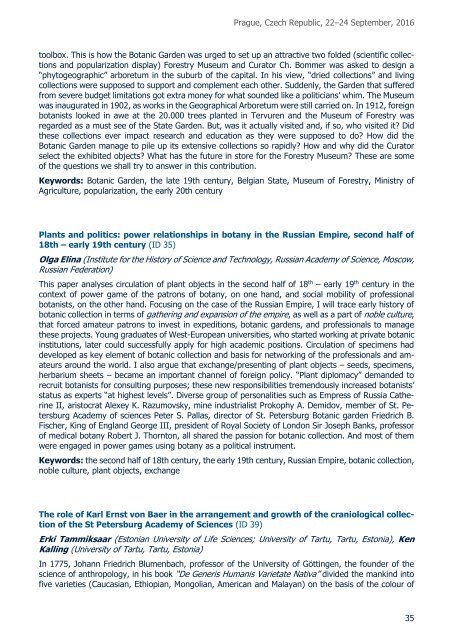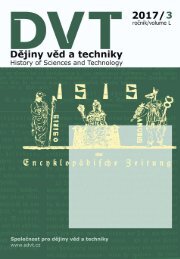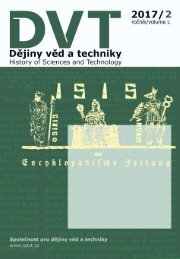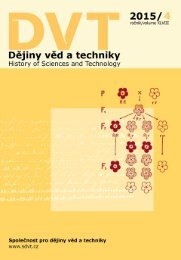7th ESHS Conference Prague 2016
7th Conference of the European Society for the History of Science Book of Abstracts
7th Conference of the European Society for the History of Science
Book of Abstracts
You also want an ePaper? Increase the reach of your titles
YUMPU automatically turns print PDFs into web optimized ePapers that Google loves.
<strong>Prague</strong>, Czech Republic, 22–24 September, <strong>2016</strong><br />
toolbox. This is how the Botanic Garden was urged to set up an attractive two folded (scientific collections<br />
and popularization display) Forestry Museum and Curator Ch. Bommer was asked to design a<br />
“phytogeographic” arboretum in the suburb of the capital. In his view, “dried collections” and living<br />
collections were supposed to support and complement each other. Suddenly, the Garden that suffered<br />
from severe budget limitations got extra money for what sounded like a politicians’ whim. The Museum<br />
was inaugurated in 1902, as works in the Geographical Arboretum were still carried on. In 1912, foreign<br />
botanists looked in awe at the 20.000 trees planted in Tervuren and the Museum of Forestry was<br />
regarded as a must see of the State Garden. But, was it actually visited and, if so, who visited it? Did<br />
these collections ever impact research and education as they were supposed to do? How did the<br />
Botanic Garden manage to pile up its extensive collections so rapidly? How and why did the Curator<br />
select the exhibited objects? What has the future in store for the Forestry Museum? These are some<br />
of the questions we shall try to answer in this contribution.<br />
Keywords: Botanic Garden, the late 19th century, Belgian State, Museum of Forestry, Ministry of<br />
Agriculture, popularization, the early 20th century<br />
Plants and politics: power relationships in botany in the Russian Empire, second half of<br />
18th – early 19th century (ID 35)<br />
Olga Elina (Institute for the History of Science and Technology, Russian Academy of Science, Moscow,<br />
Russian Federation)<br />
This paper analyses circulation of plant objects in the second half of 18 th – early 19 th century in the<br />
context of power game of the patrons of botany, on one hand, and social mobility of professional<br />
botanists, on the other hand. Focusing on the case of the Russian Empire, I will trace early history of<br />
botanic collection in terms of gathering and expansion of the empire, as well as a part of noble culture,<br />
that forced amateur patrons to invest in expeditions, botanic gardens, and professionals to manage<br />
these projects. Young graduates of West-European universities, who started working at private botanic<br />
institutions, later could successfully apply for high academic positions. Circulation of specimens had<br />
developed as key element of botanic collection and basis for networking of the professionals and amateurs<br />
around the world. I also argue that exchange/presenting of plant objects – seeds, specimens,<br />
herbarium sheets – became an important channel of foreign policy. “Plant diplomacy” demanded to<br />
recruit botanists for consulting purposes; these new responsibilities tremendously increased botanists’<br />
status as experts “at highest levels”. Diverse group of personalities such as Empress of Russia Catherine<br />
II, aristocrat Alexey K. Razumovsky, mine industrialist Prokophy A. Demidov, member of St. Petersburg<br />
Academy of sciences Peter S. Pallas, director of St. Petersburg Botanic garden Friedrich B.<br />
Fischer, King of England George III, president of Royal Society of London Sir Joseph Banks, professor<br />
of medical botany Robert J. Thornton, all shared the passion for botanic collection. And most of them<br />
were engaged in power games using botany as a political instrument.<br />
Keywords: the second half of 18th century, the early 19th century, Russian Empire, botanic collection,<br />
noble culture, plant objects, exchange<br />
The role of Karl Ernst von Baer in the arrangement and growth of the craniological collection<br />
of the St Petersburg Academy of Sciences (ID 39)<br />
Erki Tammiksaar (Estonian University of Life Sciences; University of Tartu, Tartu, Estonia), Ken<br />
Kalling (University of Tartu, Tartu, Estonia)<br />
In 1775, Johann Friedrich Blumenbach, professor of the University of Göttingen, the founder of the<br />
science of anthropology, in his book “De Generis Humanis Varietate Nativa” divided the mankind into<br />
five varieties (Caucasian, Ethiopian, Mongolian, American and Malayan) on the basis of the colour of<br />
35










